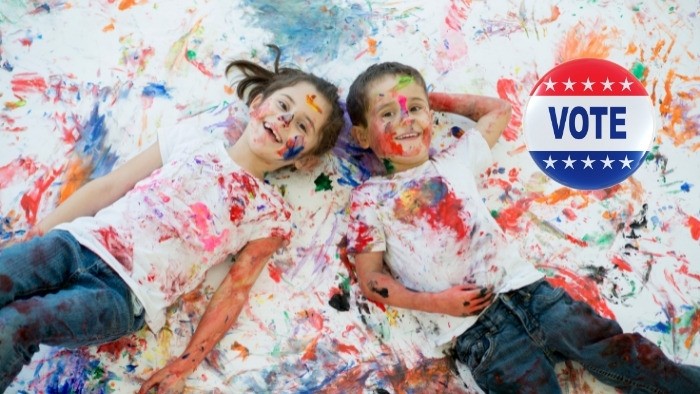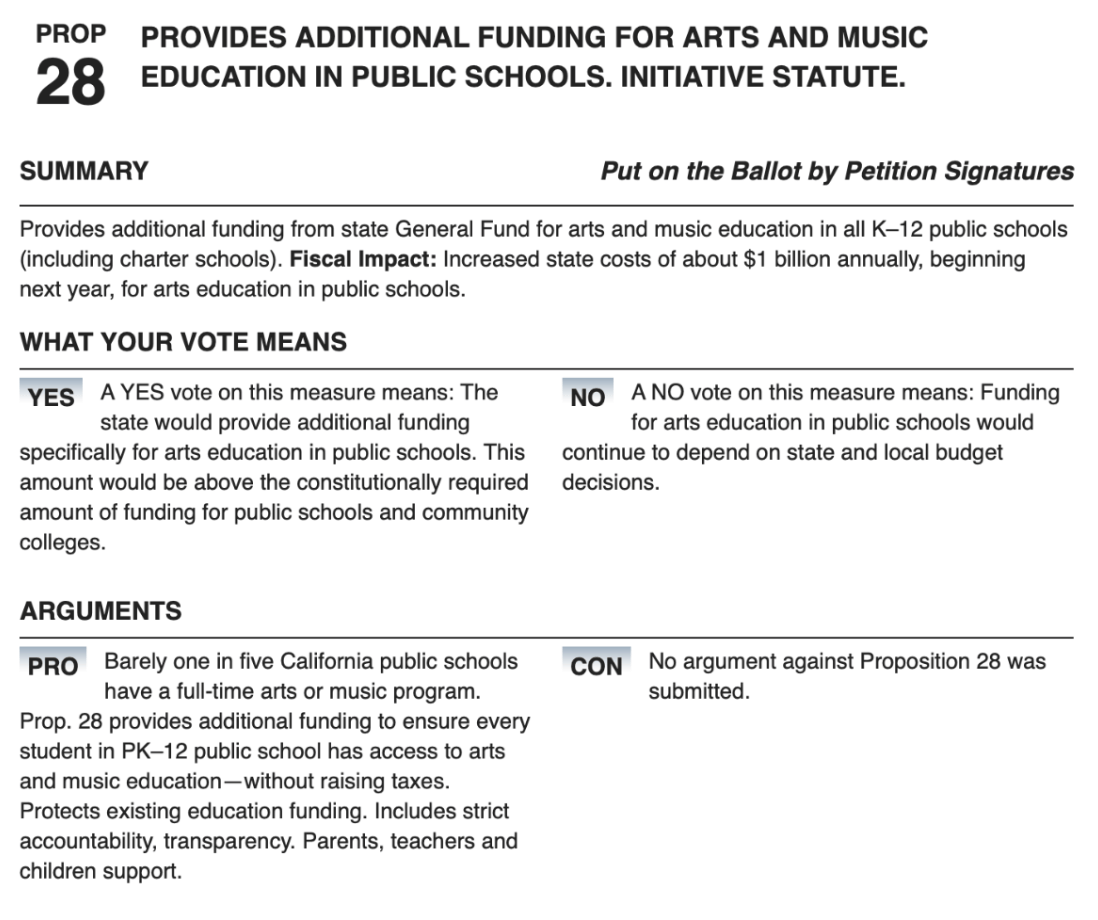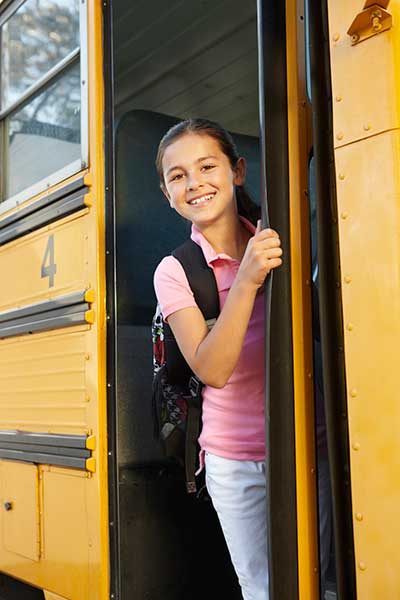Time to fund arts education

Many schools fail to teach arts
California law requires schools to provide students with education in the arts. The requirements are widely ignored.
In November of 2022, voters have a chance to fix this. If passed, Proposition 28 will provide $1 billion in additional annual funding for public schools, with the funds directed specifically to arts and music education.
Note: Proposition 28 passed by a huge margin. Funding for arts education was duly added to the Governor's budget for 2023-24. (This note was added Feb 5, 2023)
How is arts education funded today?
As of 2022, California school districts receive most of their funding through the Local Control Funding Formula (LCFF). Under this system, created in 2014, each school district has considerable flexibility to determine how it will deliver education, including arts education. In practice, data shows that many school districts have not allocated funding to provide arts education consistent with grade-level requirements:
|
California Arts Education Requirements |
|
|---|---|
|
Grades 1 to 6 shall include instruction in… |
…visual and performing arts, including dance, music, theater, and visual arts, aimed at the development of aesthetic appreciation and the skills of creative expression. |
|
Grades 7 to 12 shall offer courses in… |
|
Arts education requirements are widely ignored in California schools. A 2019 study showed that over half of students in grades six and up aren't enrolled in any art study at all. Participation in arts follows a familiar pattern: schools where more families are poor are far less likely to provide students with access to education in the arts. Students in small and/or rural high schools are also less likely to attend a school that meets state arts education requirements.

In the chart above, "FRPM" stands for Free and Reduced Price Meal eligibility, which is based on family income. The percentage of students qualifying for this program is often used as an indicator of relative income in a school community.
Why push for the arts now?
Advocates argue that the arts are more important than ever in difficult times. Psychology Today collected relevant research about it in a post titled “The Arts Are the Reset Button Students Need This School Year”. Highlights:
- "Arts-based interventions are an effective way to engage students in their own healing and may help restore students' mental well-being.
- Making art can alleviate stress, increase mindfulness, and help people process experiences and feelings in a safe space, research shows."
Student involvement in the arts is linked to stronger academic performance, higher standardized test scores, greater involvement in community service and lower dropout rates. Multiple studies show that arts education decreases feelings of anxiety and depression. The Reopening Schools Task Force of the California Department of Education urged all schools to keep the emotional well-being of all at the forefront.
How would Proposition 28 fund the arts?
The amount of money spent on education in California each year is largely determined by a formula that was set in law by Proposition 98. This initiative changed the California constitution, establishing a mechanism that calculates a legal minimum floor for education funding each year.
Policy analysts often point out that funding floors can unintentionally serve as ceilings. To make sure that funding for arts education does not cannibalize other education funding, Proposition 28 specifies that the money must come from the state general fund as an addition above Prop. 98 funding. School districts, in turn, must certify that the funds were spent in addition to existing funding for arts education programs. Beginning in 2023-24, the new funding would be one percent of the total Proposition 98 funding in the prior year. Moving forward, the minimum guarantee would be adjusted upward to reflect the additional funding required by the measure.
If passed, Proposition 28 will distribute 70 percent of the new funds to school districts and charter schools (technically LEAs) based on their enrollment. In order to deliver additional services where they are most needed, the remaining 30 percent will be distributed based on each LEA’s share of the state's low-income students.
Hiring additional staff for arts education is a priority of the proposed initiative. Districts and charter schools with more than 500 students would have to spend at least 80 percent of the additional funding on hiring staff and certifying that those staff is specifically providing arts education. The remaining money could be used for training, supplies and materials, and arts educational partnership programs.
A long-time dream
Money dedicated to the arts has been a long-time goal of arts advocates. For example, the California State PTA passed a resolution calling for guaranteed funding of arts education in 1998. (In the interest of full disclosure, I was the author of the resolution.)
Resolved: That the California State PTA and its units, councils, and districts support measures that would guarantee funding for high-quality arts education programs from pre-kindergarten through grade twelve and require that such programs be included in the school curriculum.
Who is behind this initiative?
The campaign for this initiative is led by Austin Beutner, a former Superintendent of Los Angeles Unified School District. A long list of educators, entertainers and arts organizations have signed on including Create CA, a statewide arts policy and advocacy organization. You can find out more on the campaign website.
There is no significant opposition to this measure.

What do you think?
Does your school provide a high quality arts education, as defined by the California arts content standards adopted in 2019? Do parents in your school know what arts are required?
Ed100 provides many resources to learn more about the arts:
- Lesson 6.8: The Arts: Creating in School
- Arts in Schools: Finding the Money
- Is Your School Flunking the Arts?
- The Coronavirus vs. Arts Education
A version of this post originally appeared during signature-gathering in spring of 2022.
Revised in October, 2022.
Tags on this post
Budgets Equity Funding Arts Categorical funds Creativity Local governance Mental HealthAll Tags
A-G requirements Absences Accountability Accreditation Achievement gap Administrators After school Algebra API Arts Assessment At-risk students Attendance Beacon links Bilingual education Bonds Brain Brown Act Budgets Bullying Burbank Business Career Carol Dweck Categorical funds Catholic schools Certification CHAMP Change Character Education Chart Charter schools Civics Class size CMOs Collective bargaining College Common core Community schools Contest Continuous Improvement Cost of education Counselors Creativity Crossword CSBA CTA Dashboard Data Dialogue District boundaries Districts Diversity Drawing DREAM Act Dyslexia EACH Early childhood Economic growth EdPrezi EdSource EdTech Education foundations Effort Election English learners Equity ESSA Ethnic studies Ethnic studies Evaluation rubric Expanded Learning Facilities Fake News Federal Federal policy Funding Gifted Graduation rates Grit Health Help Wanted History Home schools Homeless students Homework Hours of opportunity Humanities Independence Day Indignation Infrastructure Initiatives International Jargon Khan Academy Kindergarten LCAP LCFF Leaderboard Leadership Learning Litigation Lobbyists Local control Local funding Local governance Lottery Magnet schools Map Math Media Mental Health Mindfulness Mindset Myth Myths NAEP National comparisons NCLB Nutrition Pandemic Parcel taxes Parent Engagement Parent Leader Guide Parents peanut butter Pedagogy Pensions personalized Philanthropy PISA Planning Policy Politics population Poverty Preschool Prezi Private schools Prize Project-based learning Prop 13 Prop 98 Property taxes PTA Purpose of education puzzle Quality Race Rating Schools Reading Recruiting teachers Reform Religious education Religious schools Research Retaining teachers Rigor School board School choice School Climate School Closures Science Serrano vs Priest Sex Ed Site Map Sleep Social-emotional learning Song Special ed Spending SPSA Standards Strike STRS Student motivation Student voice Success Suicide Summer Superintendent Suspensions Talent Teacher pay Teacher shortage Teachers Technology Technology in education Template Test scores Tests Time in school Time on task Trump Undocumented Unions Universal education Vaccination Values Vaping Video Volunteering Volunteers Vote Vouchers Winners Year in ReviewSharing is caring!
Password Reset
Search all lesson and blog content here.
Login with Email
We will send your Login Link to your email
address. Click on the link and you will be
logged into Ed100. No more passwords to
remember!














Questions & Comments
To comment or reply, please sign in .